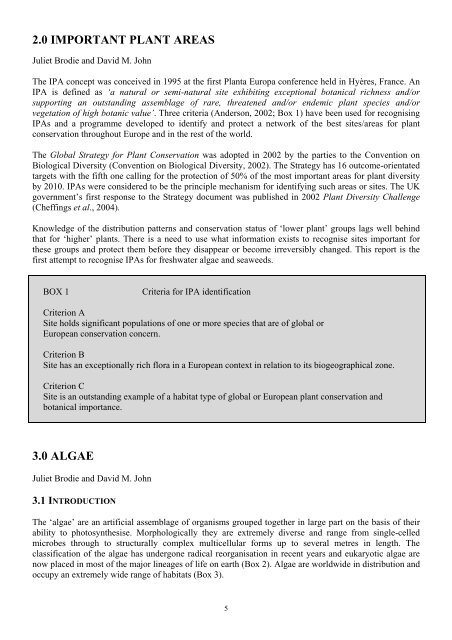Important Plant Areas for algae - Natural History Museum
Important Plant Areas for algae - Natural History Museum
Important Plant Areas for algae - Natural History Museum
You also want an ePaper? Increase the reach of your titles
YUMPU automatically turns print PDFs into web optimized ePapers that Google loves.
2.0 IMPORTANT PLANT AREAS<br />
Juliet Brodie and David M. John<br />
The IPA concept was conceived in 1995 at the first <strong>Plant</strong>a Europa conference held in Hyères, France. An<br />
IPA is defined as ‘a natural or semi-natural site exhibiting exceptional botanical richness and/or<br />
supporting an outstanding assemblage of rare, threatened and/or endemic plant species and/or<br />
vegetation of high botanic value’. Three criteria (Anderson, 2002; Box 1) have been used <strong>for</strong> recognising<br />
IPAs and a programme developed to identify and protect a network of the best sites/areas <strong>for</strong> plant<br />
conservation throughout Europe and in the rest of the world.<br />
The Global Strategy <strong>for</strong> <strong>Plant</strong> Conservation was adopted in 2002 by the parties to the Convention on<br />
Biological Diversity (Convention on Biological Diversity, 2002). The Strategy has 16 outcome-orientated<br />
targets with the fifth one calling <strong>for</strong> the protection of 50% of the most important areas <strong>for</strong> plant diversity<br />
by 2010. IPAs were considered to be the principle mechanism <strong>for</strong> identifying such areas or sites. The UK<br />
government’s first response to the Strategy document was published in 2002 <strong>Plant</strong> Diversity Challenge<br />
(Cheffings et al., 2004).<br />
Knowledge of the distribution patterns and conservation status of ‘lower plant’ groups lags well behind<br />
that <strong>for</strong> ‘higher’ plants. There is a need to use what in<strong>for</strong>mation exists to recognise sites important <strong>for</strong><br />
these groups and protect them be<strong>for</strong>e they disappear or become irreversibly changed. This report is the<br />
first attempt to recognise IPAs <strong>for</strong> freshwater <strong>algae</strong> and seaweeds.<br />
BOX 1<br />
Criteria <strong>for</strong> IPA identification<br />
Criterion A<br />
Site holds significant populations of one or more species that are of global or<br />
European conservation concern.<br />
Criterion B<br />
Site has an exceptionally rich flora in a European context in relation to its biogeographical zone.<br />
Criterion C<br />
Site is an outstanding example of a habitat type of global or European plant conservation and<br />
botanical importance.<br />
3.0 ALGAE<br />
Juliet Brodie and David M. John<br />
3.1 INTRODUCTION<br />
The ‘<strong>algae</strong>’ are an artificial assemblage of organisms grouped together in large part on the basis of their<br />
ability to photosynthesise. Morphologically they are extremely diverse and range from single-celled<br />
microbes through to structurally complex multicellular <strong>for</strong>ms up to several metres in length. The<br />
classification of the <strong>algae</strong> has undergone radical reorganisation in recent years and eukaryotic <strong>algae</strong> are<br />
now placed in most of the major lineages of life on earth (Box 2). Algae are worldwide in distribution and<br />
occupy an extremely wide range of habitats (Box 3).<br />
5

















